Influence of Site Conditions and Quality of Birch Wood on Its Properties and Utilization after Heat Treatment. Part II—Surface Properties and Marketing Evaluation of the Effect of the Treatment on Final Usage of Such Wood
Abstract
:1. Introduction
2. Materials and Methods
2.1. Experimental Tests
2.2. Marketing Analysis
3. Results and Discussion
3.1. Evaluation of the Experiments
3.2. Marketing Evaluation
3.2.1. The Preference in the Sample in the Case of Purchasing Accessories and New Furnishings
3.2.2. The Sensitivity of the Measurement of the Attractiveness of the Individual Solid Birch Wood Samples
3.2.3. The Sensitivity of the Measurement of the Attractiveness of the Individual Birch Veneer Samples
4. Conclusions
Author Contributions
Funding
Acknowledgments
Conflicts of Interest
Appendix A

References
- Borůvka, V.; Dudík, R.; Zeidler, A.; Holeček, T. Influence of Site Conditions and Quality of Birch Wood on Its Properties and Utilization after Heat Treatment. Part I—Elastic and Strength Properties, Relationship to Water and Dimensional Stability. Forests 2019, 10, 189. [Google Scholar] [CrossRef] [Green Version]
- Dudík, R.; Šišák, L.; Riedl, M. Regeneration of declining spruce stands in the Czech Republic economic view of an alternative species composition. In Book of Abstracts Sustainable Forest Management for the Future–the role of managerial economics and accounting, Proceedings of the International Scientific Conference, Zagreb, Croatia, 10–12 May 2018; Posavec, S., Ed.; Faculty of Forestry University of Zagreb: Zagreb, Croatia, 2018; pp. 25–26. [Google Scholar]
- Bhuiyan, N. A Framework for successful new product development. J. Ind. Eng. Manag. 2011, 4, 746–770. [Google Scholar] [CrossRef] [Green Version]
- Ulrich, K.T.; Eppinger, S.D. Product Design and Development, 4th ed.; McGrawHill: New York, NY, USA, 2007; p. 384. [Google Scholar]
- Cooper, R.G. The drivers of success in new-product development. Ind. Mark. Manag. 2019, 76, 36–47. [Google Scholar] [CrossRef]
- Arruda, L.M.; Del Menezzi, C.H.S. Effect of thermomechanical treatment on physical properties of wood veneers. Int. Wood Prod. J. 2013, 4, 217–224. [Google Scholar] [CrossRef]
- Barnett, J.R.; Jeronimidis, G. Wood Quality and its Biological Basis; Blackwell Publishing: Oxford UK, 2003; p. 226. ISBN 978-1-84127-319-8. [Google Scholar]
- Bastani, A.; Adamopoulos, S.; Militz, H. Water uptake and wetting behaviour of furfurylated, N-methylol melamine modified and heat-treated wood. Holz Als Roh-Und Werkst. 2015, 73, 627–634. [Google Scholar] [CrossRef]
- Bryne, L.E.; Wålinder, M.E. Ageing of modified wood. Part 1: Wetting properties of acetylated, furfurylated, and thermally modified wood. Holzforsch. 2010, 64, 295–304. [Google Scholar] [CrossRef]
- De Oliveira, R.M.; Brisolari, A.; Sales, A.; Gonçalves, D. Wettability, Shrinkage and Color Changes of Araucaria angustifolia After Heating Treatment. Mater. Res. 2010, 13, 351–354. [Google Scholar] [CrossRef] [Green Version]
- Fang, C.H.; Mariotti, N.; Cloutier, A.; Koubaa, A.; Blanchet, P. Densification of wood veneers by compression combined with heat and steam. Holz Als Roh-Und Werkst. 2011, 70, 155–163. [Google Scholar] [CrossRef]
- Fengel, D.; Wegener, G. Wood: Chemistry, Ultrastructure, Reactions, 2nd ed.; Walter de Gruyter: Berlin, Germany, 1989; p. 613. ISBN 978-0899255934. [Google Scholar]
- ITA (International Thermowood Association). Thermowood Handbook; International Thermowood Association: Helsinki, Finland, 2003; Available online: https://asiakas.kotisivukone.com/files/en.thermowood.palvelee.fi/downloads/tw_handbook_080813.pdf (accessed on 26 November 2019).
- Liptáková, E.; Kudela, J. Analysis of the Wood-Wetting Process. Holzforschung 1994, 48, 139–144. [Google Scholar] [CrossRef]
- Liptáková, E.; Kudela, J.; Bastl, Z.; Spirovová, I. Influence of Mechanical Surface Treatment of Wood on the Wetting Process. Holzforschung 1995, 49, 369–375. [Google Scholar] [CrossRef]
- Kocaefe, D.; Poncsak, S.; Doré, G.; Younsi, R. Effect of heat treatment on the wettability of white ash and soft maple by water. Holz Als Roh-Und Werkst. 2008, 66, 355–361. [Google Scholar] [CrossRef]
- Korkut, S.; Budacki, M. The effects of high-temperature heat-treatment on physical properties and surface roughness of rowan (Sorbus Aucuparia, L.) wood. Wood Res. 2010, 55, 67–78. [Google Scholar]
- Navi, P.; Girardet, F. Effects of Thermo-Hydro-Mechanical Treatment on the Structure and Properties of Wood. Holzforschung 2000, 54, 287–293. [Google Scholar] [CrossRef]
- Navi, P.; Pizzi, A. Property changes in thermo-hydro-mechanical processing. Holzforschung 2015, 69, 863–873. [Google Scholar] [CrossRef]
- Navi, P.; Sandberg, D. Thermo-Hydro-Mechanical Wood Processing, 1st ed.; CRC Press: Lausanne, Switzerland, 2012; p. 280. ISBN 978-1439860427. [Google Scholar]
- Pánek, M.; Dvořák, O.; Eliška, O.; Šimůnková, K.; Zeidler, A. Effectiveness of Two Different Hydrophobic Topcoats for Increasing of Durability of Exterior Coating Systems on Oak Wood. Coatings 2019, 9, 280. [Google Scholar] [CrossRef] [Green Version]
- Petrissans, M.; Gerardin, P.; El Bakali, I.; Serraj, M. Wettability of Heat-Treated Wood. Holzforschung 2003, 57, 301–307. [Google Scholar] [CrossRef]
- Reiniati, I.; Osman, N.B.; Mc Donald, A.G.; Laborie, M.-P. Linear viscoelasticity of hot-pressed hybrid poplar relates to densification and to the in situ molecular parameters of cellulose. Ann. For. Sci. 2014, 72, 693–703. [Google Scholar] [CrossRef] [Green Version]
- Reinprecht, L. Wood Deterioration, Protection and Maintenance, 1st ed.; John Wiley & Sons: Oxford, UK, 2016; p. 376. ISBN 978-1119106531. [Google Scholar]
- Sandberg, D.; Haller, P.; Navi, P. Thermo-hydro and thermo-hydro-mechanical wood processing: An opportunity for future environmentally friendly wood products. Wood Mater. Sci. Eng. 2013, 8, 64–88. [Google Scholar] [CrossRef] [Green Version]
- Sandberg, D.; Kutnar, A.; Mantanis, G.I. Wood modification technologies–a review. iForest Biogeosci. For. 2017, 10, 895–908. [Google Scholar] [CrossRef] [Green Version]
- Shmulsky, R.; Jones, P.D. Forest Products and Wood Science: An Introduction; Wiley: Hoboken, NJ, USA, 2011; p. 496. [Google Scholar]
- Tarmian, A.; Mastouri, A. Water-repellent efficiency of thermally modified wood as affected by its permeability. J. For. Res. 2017, 29, 859–867. [Google Scholar] [CrossRef]
- Tsoumis, G.T. Science and Technology of Wood–Structure, Properties, Utilization, 1st ed.; Van Nostrand Reinhold: New York, NY, USA, 1991; p. 494. ISBN 9780442239855. [Google Scholar]
- Unsal, O.; Candan, Z.; Korkut, S. Wettability and roughness characteristics of modified wood boards using a hot-press. Ind. Crop. Prod. 2011, 34, 1455–1457. [Google Scholar] [CrossRef]
- Zobel, B.J.; Buijtenen, J.P. Wood Variation: Its Causes and Control, 1st ed.; Springer: Berlin/Heidelberg, Germany, 1989; p. 363. ISBN 978-3-642-74071-8. [Google Scholar]
- Viitaniemi, P.; Ranta-Maunus, A.; Jämsä, S.; Ek, P. Method for Processing of Wood at Elevated Temperatures. Patent EP-0759137 VTT, 11 May 1995. [Google Scholar]
- Andersone, I.; Dobele, G.; Andersons, B.; Kurnosova, N.; Kuka, E.; Volperts, A.; Grinins, J. A study of thermo-hydro-treated (THT) birch wood by chemical analysis and Py-GC/MS. Holzforschung 2019, 73, 653–661. [Google Scholar] [CrossRef]
- Bekhta, P.; Krystofiak, T.; Proszyk, S.; Lis, B. Evaluation of Dynamic Contact Angle of Loose and Tight Sides of Thermally Compressed Birch Veneer. Drv. Ind. 2018, 69, 387–394. [Google Scholar] [CrossRef]
- Bekhta, P.; Proszyk, S.; Krystofiak, T.; Sedliačik, J.; Novak, I.; Mamoňová, M. Effects of short-term thermomechanical densification on the structure and properties of wood veneers. Wood Mater. Sci. Eng. 2015, 12, 40–54. [Google Scholar] [CrossRef]
- Bekhta, P.; Proszyk, S.; Krystofiak, T.; Mamoňová, M.; Pinkowski, G.; Lis, B. Effect of thermomechanical densification on surface roughness of wood veneers. Wood Mater. Sci. Eng. 2014, 9, 233–245. [Google Scholar] [CrossRef]
- Irbe, I.; Grinins, J.; Andersone, I.; Andersons, B. Susceptibility of thermo-hydro-treated birch plywood to mould and blue stain fungi. Wood Mater. Sci. Eng. 2017, 13, 296–304. [Google Scholar] [CrossRef]
- Kúdela, J.; Rešetka, M.; Rademacher, P.; Dejmal, A. Influence of pressing parameters on surface properties of compressed beech wood. Wood Res. 2017, 62, 939–950. [Google Scholar]
- Kvietková, M. The Effect of Thermal Treatment of Birch Wood on the Cutting Power of Plain Milling. BioResources 2015, 10, 8528–8538. [Google Scholar] [CrossRef]
- Kvietková, M.; Gaff, M.; Gašparík, M.; Kaplan, L.; Barcík, Š. Surface Quality of Milled Birch Wood after Thermal Treatment at Various Temperatures. BioResources 2015, 10, 6512–6521. [Google Scholar] [CrossRef]
- Rohumaa, A.; Hunt, C.; Frihart, C.R.; Saranpaa, P.; Ohlmeyer, M.; Hughes, M. The influence of felling season and log-soaking temperature on the wetting and phenol formaldehyde adhesive bonding characteristics of birch veneer. Holzforschung 2014, 68, 965–970. [Google Scholar] [CrossRef]
- Sundqvist, B. Color response of Scots pine (Pinus sylvestris), Norway spruce (Picea abies) and birch (Betula pubescens) subjected to heat treatment in capillary phase. Holz Als Roh-Und Werkst. 2002, 60, 106–114. [Google Scholar] [CrossRef]
- Bekhta, P.; Sedliačik, J.; Jones, D. Effect of short-term thermomechanical densification of wood veneers on the properties of birch plywood. Holz Als Roh-Und Werkst. 2017, 76, 549–562. [Google Scholar] [CrossRef]
- Grinins, J.; Andersons, B.; Irbe, I.; Andersone, I.; Meija-Feldmane, A.; Janberga, A.; Pavlovics, G.; Sansonetti, E. Thermo-hydro treated (THT) birch veneers for producing plywood with improved properties. Holzforschung 2016, 70, 739–746. [Google Scholar] [CrossRef]
- Kutnar, A.; Kamke, F.A.; Šernek, M. Density profile and morphology of viscoelastic thermal compressed wood. Wood Sci. Technol. 2008, 43, 57–68. [Google Scholar] [CrossRef]
- Kutnar, A.; Kamke, F.A.; Petrič, M.; Šernek, M. The influence of viscoelastic thermal compression on the chemistry and surface energetics of wood. Colloids Surf. A Physicochem. Eng. Asp. 2008, 329, 82–86. [Google Scholar] [CrossRef]
- Dos Santos, D.V.B.; De Moura, L.F.; Brito, J.O. Effect of heat treatment on color, weight loss, specific gravity and equilibrium moisture content of two low market valued tropical woods. Wood Res. 2014, 59, 2–253. [Google Scholar]
- De Cademartori, P.H.G.; Mattos, B.D.; Missio, A.L.; Gatto, D.A. Colour responses of two fast-growing hardwoods to two-step steam-heat treatments. Mater. Res. 2014, 17, 487–493. [Google Scholar] [CrossRef] [Green Version]
- Sedlar, T.; Šefc, B.; Stojnić, S.; Jarc, A.; Perić, I.; Sinković, T. Tvrdoća toplinski modificirane bukovine i grabovine. Šumarski List 2019, 143, 433. [Google Scholar] [CrossRef]
- Zanuttini, R.; Castro, G.; Cremonini, C.; Negro, F.; Palanti, S. Thermo-vacuum treatment of poplar (Populus spp.) plywood. Holzforschung 2019, 74, 60–67. [Google Scholar] [CrossRef]
- Rosu, D.; Teacă, C.-A.; Bodîrlău, R.; Rosu, L. FTIR and color change of the modified wood as a result of artificial light irradiation. J. Photochem. Photobiol. B Biol. 2010, 99, 144–149. [Google Scholar] [CrossRef]
- Candelier, K.; Thévenon, M.-F.; Pétrissans, A.; Dumarcay, S.; Gérardin, P.; Petrissans, M. Control of wood thermal treatment and its effects on decay resistance: A review. Ann. For. Sci. 2016, 73, 571–583. [Google Scholar] [CrossRef] [Green Version]
- Jirouš-Rajković, V.; Miklečić, J. Heat-Treated Wood as a Substrate for Coatings, Weathering of Heat-Treated Wood, and Coating Performance on Heat-Treated Wood. Adv. Mater. Sci. Eng. 2019, 2019, 1–9. [Google Scholar] [CrossRef] [Green Version]
- Loučanová, E.; Paluš, H.; Dzian, M. A Course of Innovations in Wood Processing Industry within the Forestry-Wood Chain in Slovakia: A Q Methodology Study to Identify Future Orientation in the Sector. Forests 2017, 8, 210. [Google Scholar] [CrossRef] [Green Version]
- Parobek, J.; Paluš, H. Modelling of wood and wood products flow in the Slovak Republic. In Proceedings of the COST Conference on a European Wood Processing Strategy: Future Resources Matching Products and Innovations, Milan, Italy, 30 May–3 June 2008; Ghent University: Ghent, Belgium, 2008; pp. 93–99. [Google Scholar]
- Palátová, P. Value added in sawmilling industry in the Czech Republic. Cent. Eur. For. J. 2019, 65, 60–65. [Google Scholar] [CrossRef]
- Oblak, L.; Glavonjić, B.; Barčić, A.P.; Govedič, T.B.; Grošelj, P. Preferences of Different Target Groups of Consumers in Case of Furniture Purchase. Drv. Ind. 2020, 71, 79–87. [Google Scholar] [CrossRef]
- Kaputa, V.; Šupín, M. Consumer preferences for furniture. In Wood Processing and Furniture Manufacturing: Present Conditions, Opportunities and New Challenges, Vyhne, Slovakia, 6–8 October 2010; Paluš, H., Ed.; International Association for Economics and Management in Wood Processing and Furniture Manufacturing–WoodEMA, i.a.: Zagreb, Croatia, 2010; pp. 81–90. [Google Scholar]
- ČSN EN ISO 11664-4. Kolorimetrie-Část 4: Kolorimetrický Prostor CIE 1976 L*a*b* (Colorimetry–Part 4: CIE 1976 L*a*b* Colour Space); Czech Office for Standards, Metrology and Testing: Prague, Czech Republic, 1 November 2011.
- ČSN EN ISO 11664-6. Kolorimetrie–Část 6: CIEDE2000 Vzorce Výpočtu Barevného Rozdílu (Colorimetry-Part 6: CIEDE2000 Colour-Difference Formula); Czech Office for Standards, Metrology and Testing: Prague, Czech Republic, 1 March 2017.
- ČSN EN ISO 4287. Geometrické Požadavky na Výrobky (GPS)-Struktura Povrchu: Profilová Metoda-Termíny, Definice a Parametry Struktury Povrchu (Geometrical Product Specifications (GPS)-Surface Texture: Profile Method-Terms, Definitions and Surface Texture Parameters); Czech Standards Institute: Prague, Czech Republic, 1 April 1999.
- ČSN EN ISO 4288. Geometrické Požadavky na Výrobky (GPS)-Struktura Povrchu: Profilová Metoda-Pravidla a Postupy Pro Posuzování Struktury Povrchu (Geometrical Product Specifications (GPS)-Surface Texture: Profile Method–Rules and Procedures for the Assesment of Surface Texture); Czech Standards Institute: Prague, Czech Republic, 1 April 1999.
- ČSN EN 1534. Dřevěné Podlahoviny-Stanovení Odolnosti Proti Vtisku-Metoda Zkoušení (Wood Flooring-Determination of Resistence to Indentation-Test Method); Czech Office for Standards, Metrology and Testing: Prague, Czech Republic, 1 May 2011.
- ČSN 49 0108. Drevo. Zisťovanie Hustoty (Wood. Determination of the Density); Czech Standards Institute: Prague, Czech Republic, 1 March 1993.
- Wonnacot, T.H.; Wonnacot, R.J. Introductory Statistics, 3rd ed.; John Wiley: New York, NY, USA, 1977; p. 650. [Google Scholar]
- Borůvka, V.; Zeidler, A.; HoleČek, T.; Dudík, R. Elastic and Strength Properties of Heat-Treated Beech and Birch Wood. Forests 2018, 9, 197. [Google Scholar] [CrossRef] [Green Version]
- Chen, T.-L. A Study of the Visual Physical Characteristics and Psychological Images of Select Taiwanese Hardwoods. For. Prod. J. 2012, 62, 18–24. [Google Scholar] [CrossRef]
- Dudík, R.; Palátová, P.; Borůvka, V.; Riedl, M. The prices and utilization of birch and beech raw wood in the Czech Republic–a Bioeconomic Dimension. In Increasing the Use of Wood in the Global Bio–Economy, Proceedings of the Scientific Conference, Belgrade, Serbia, 26–28 September 2018; Glavonjić, B., Ed.; University of Belgrade–Faculty of Forestry: Belgrade, Serbia, 2018; pp. 90–95. [Google Scholar]





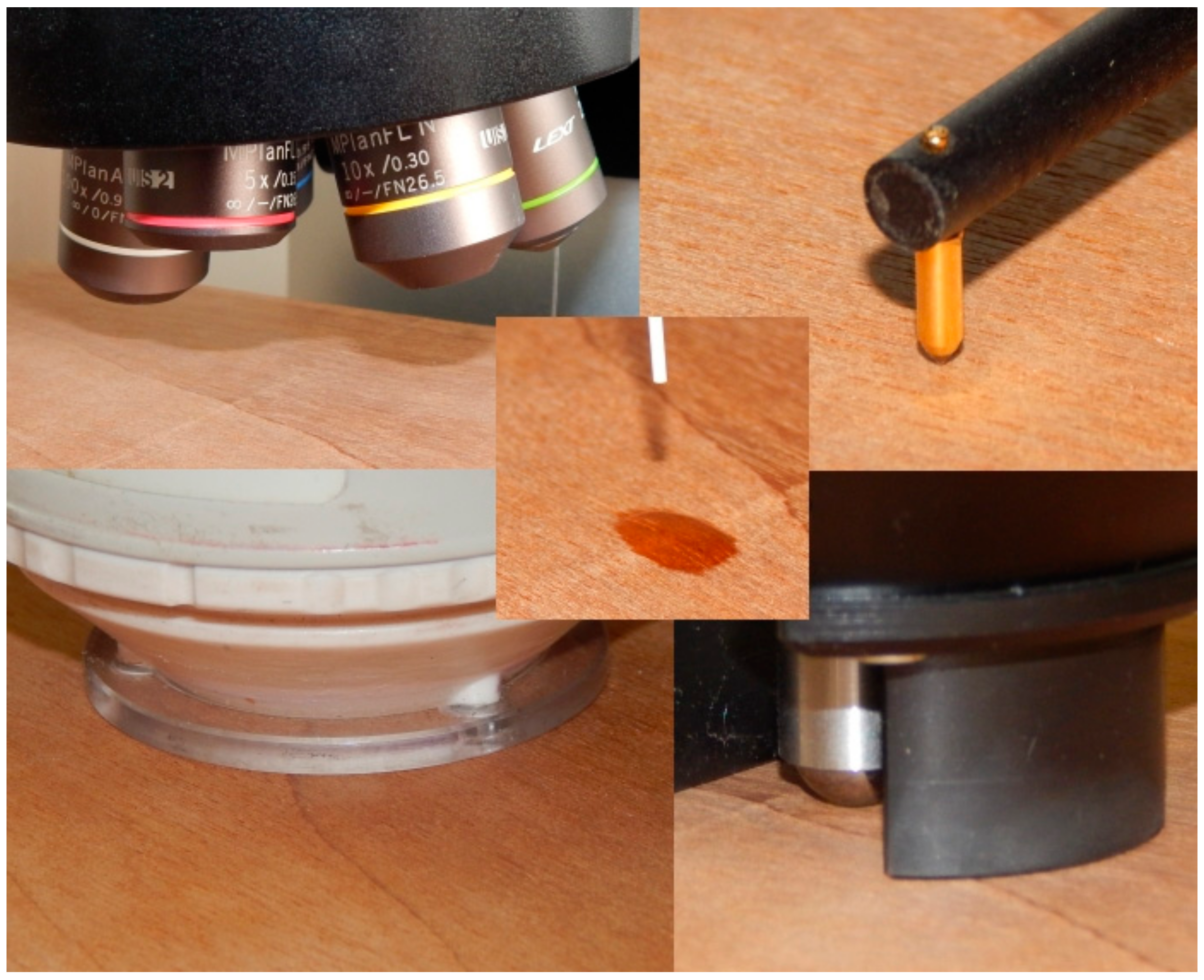
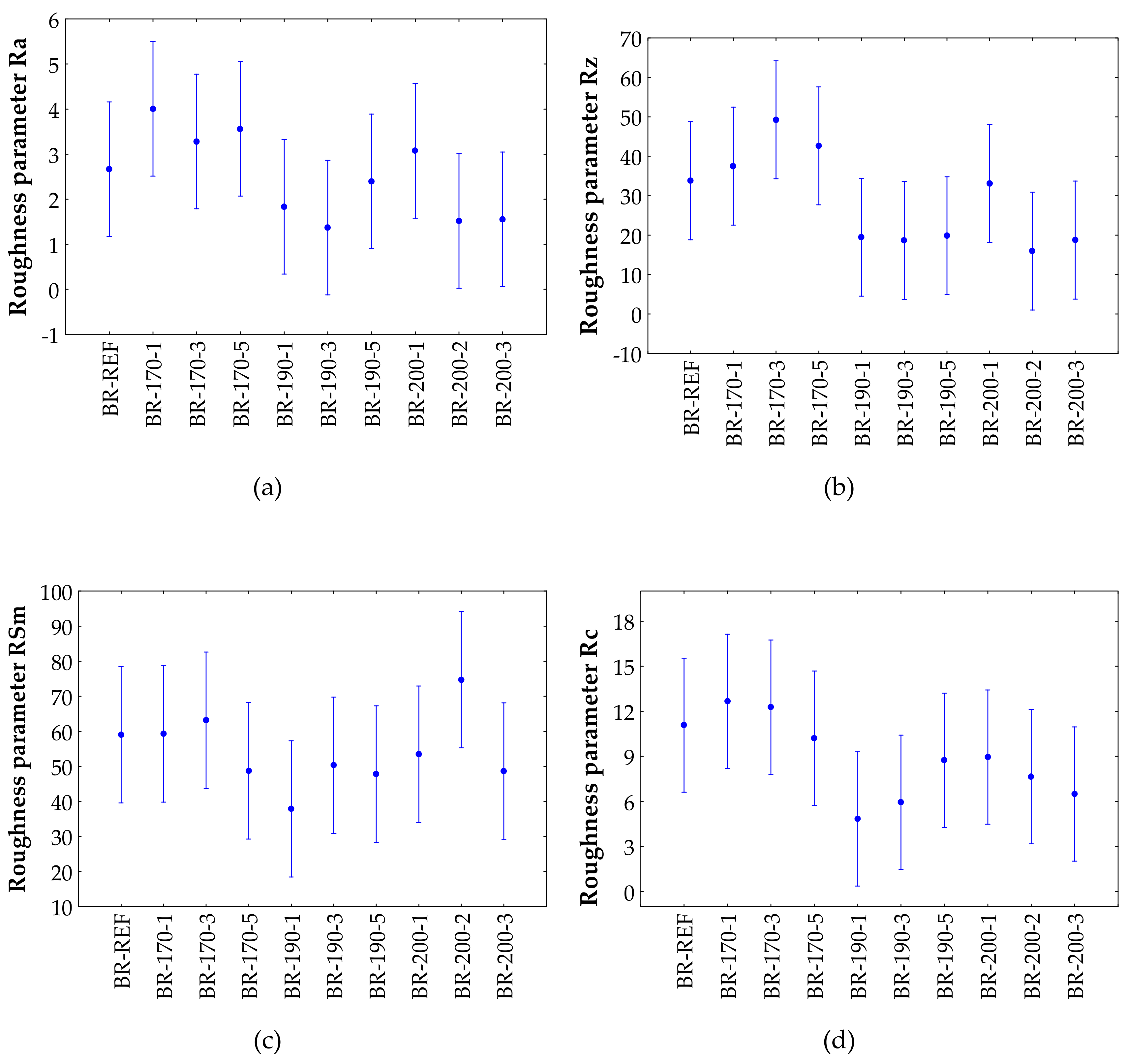

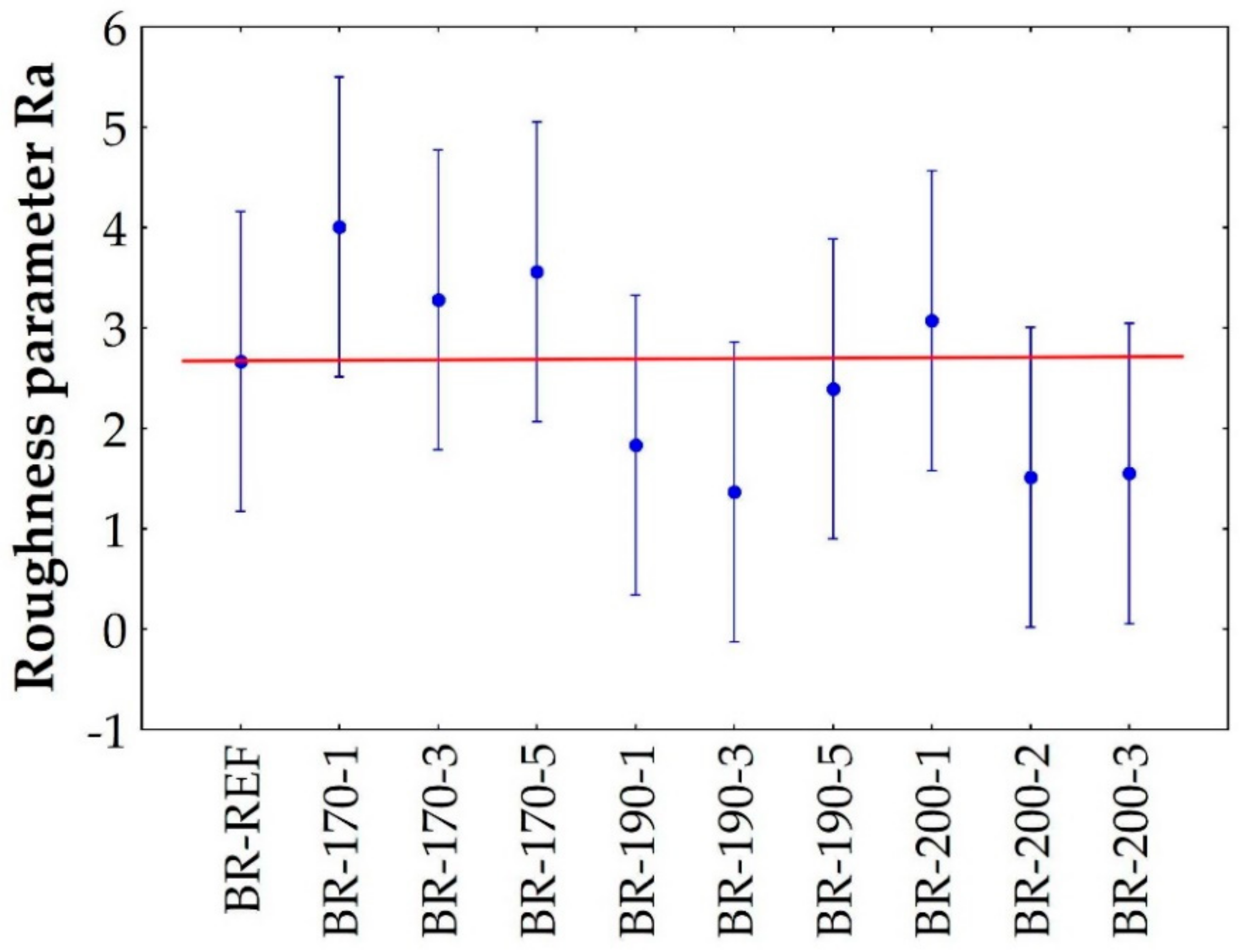
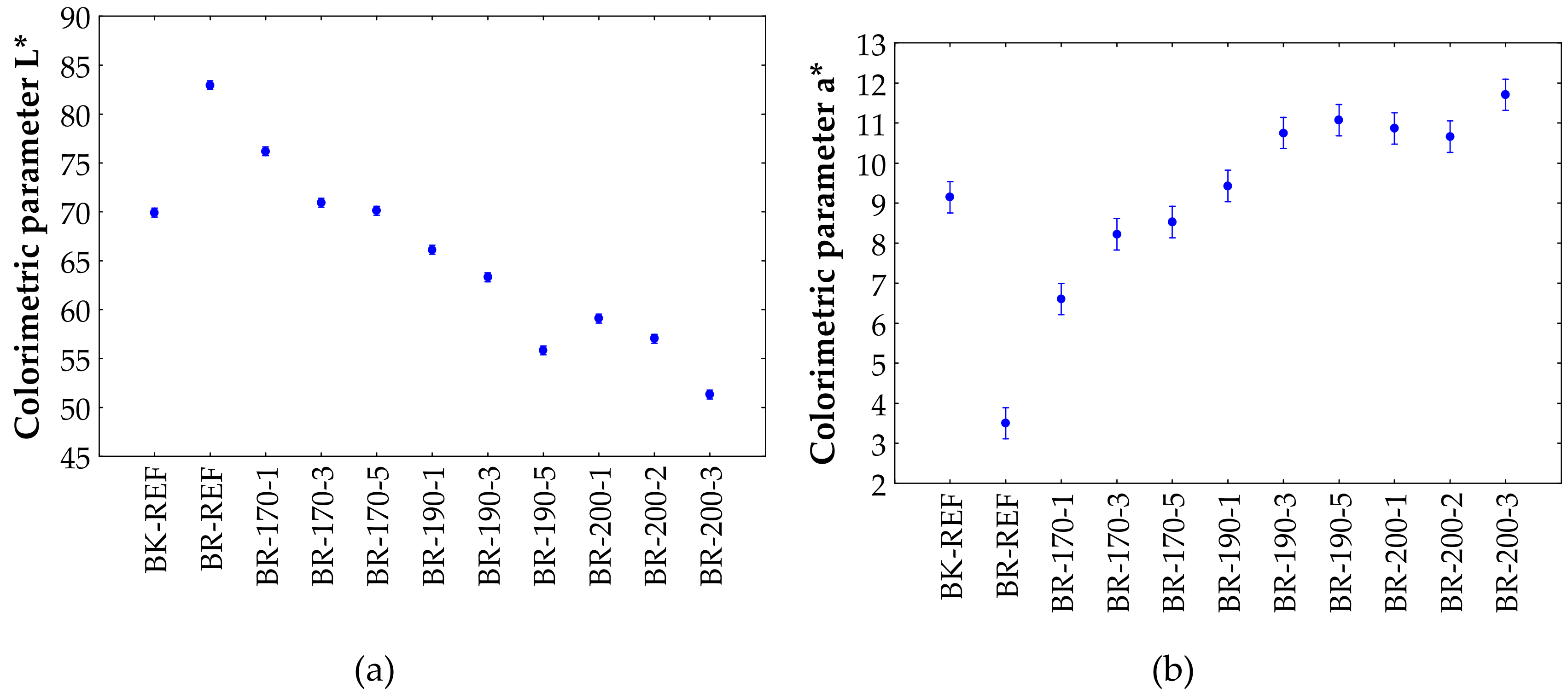
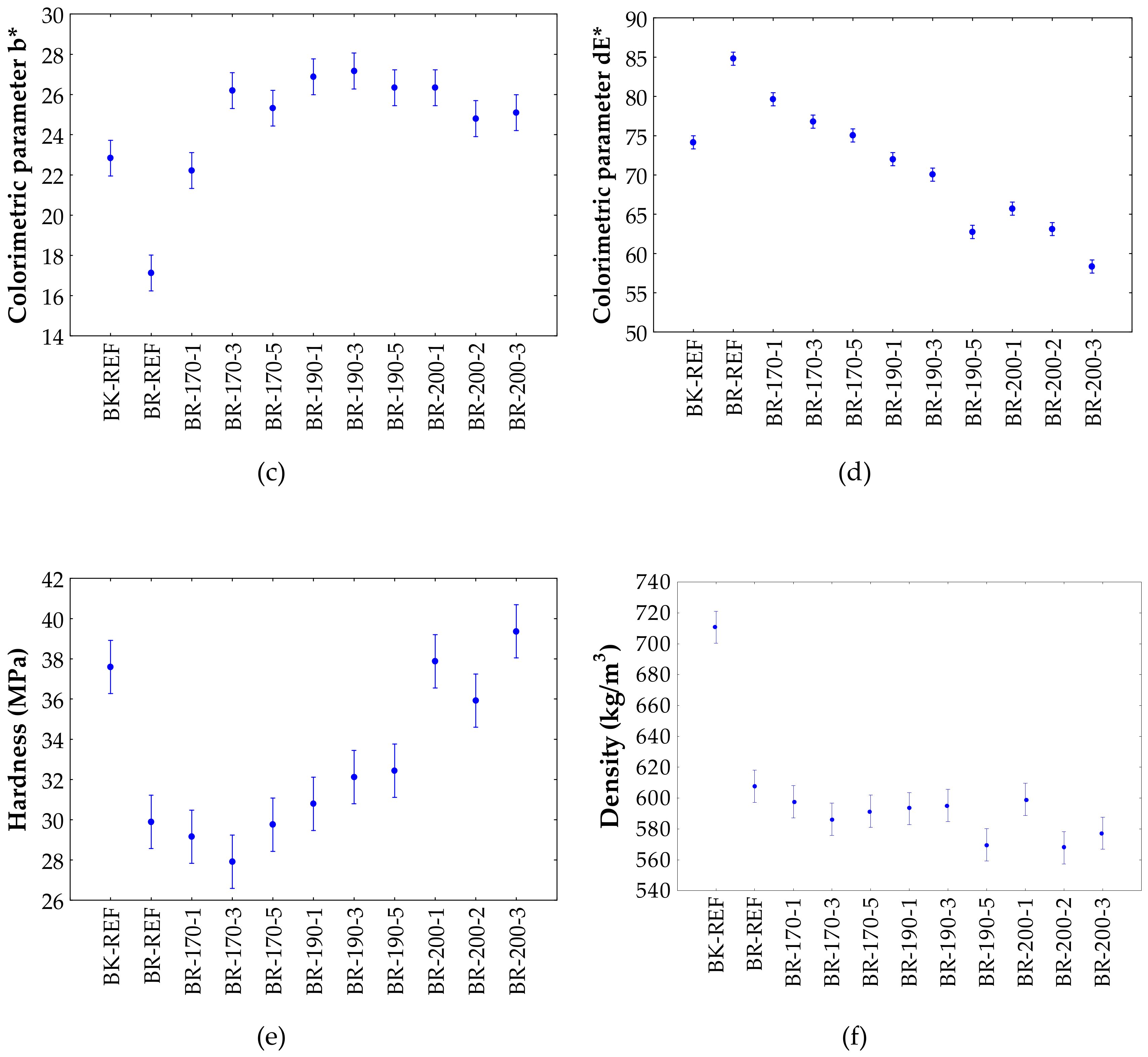

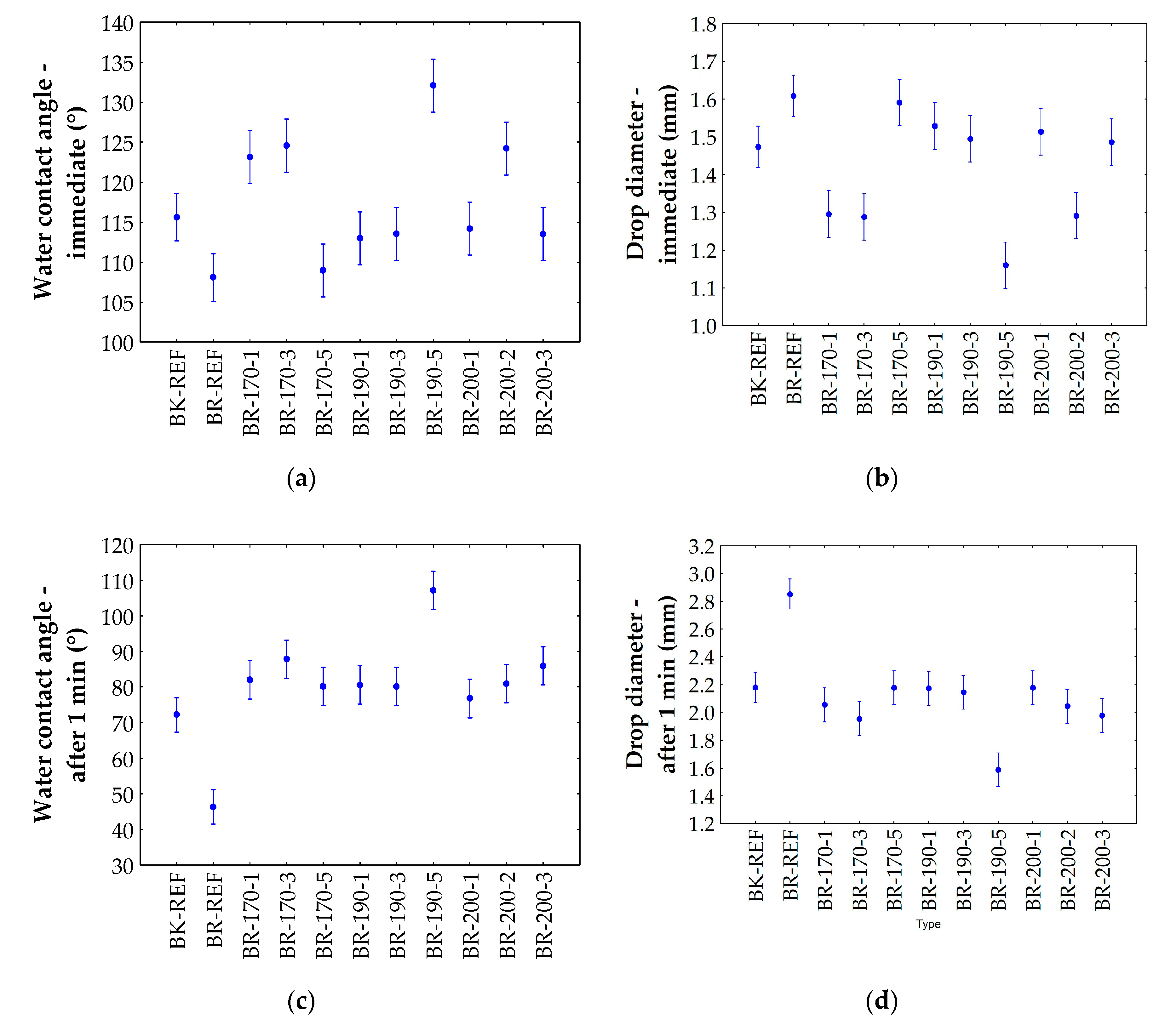
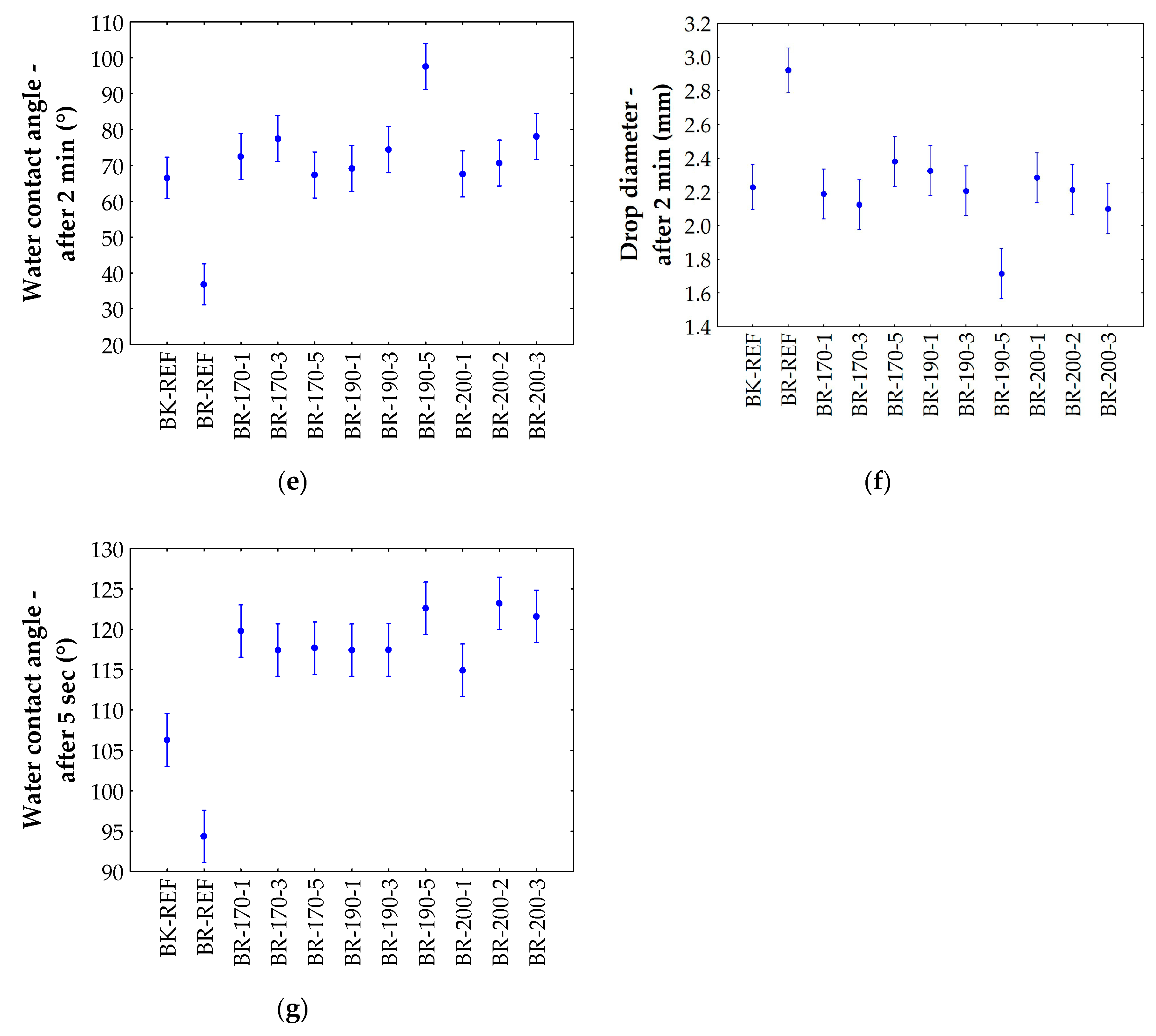

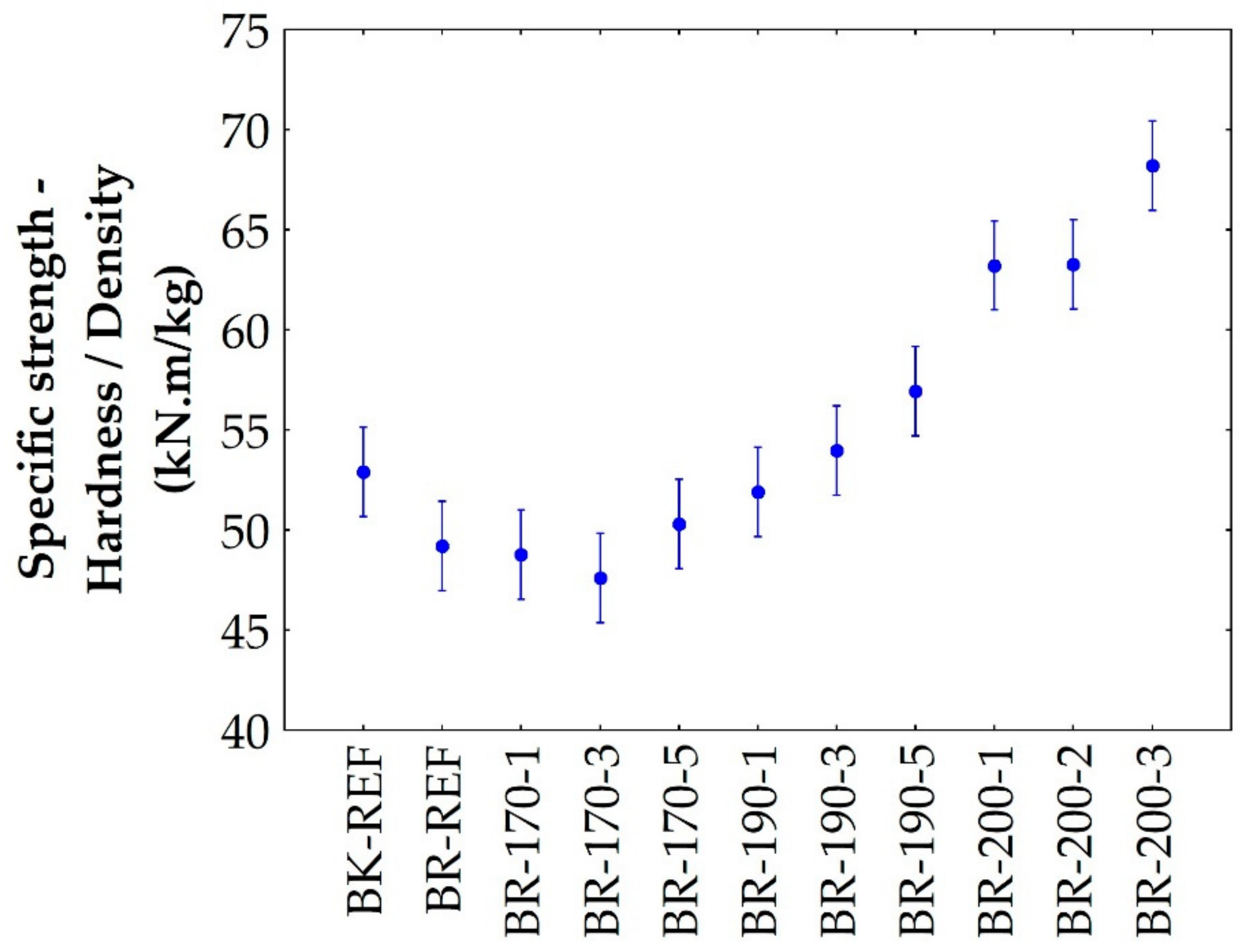
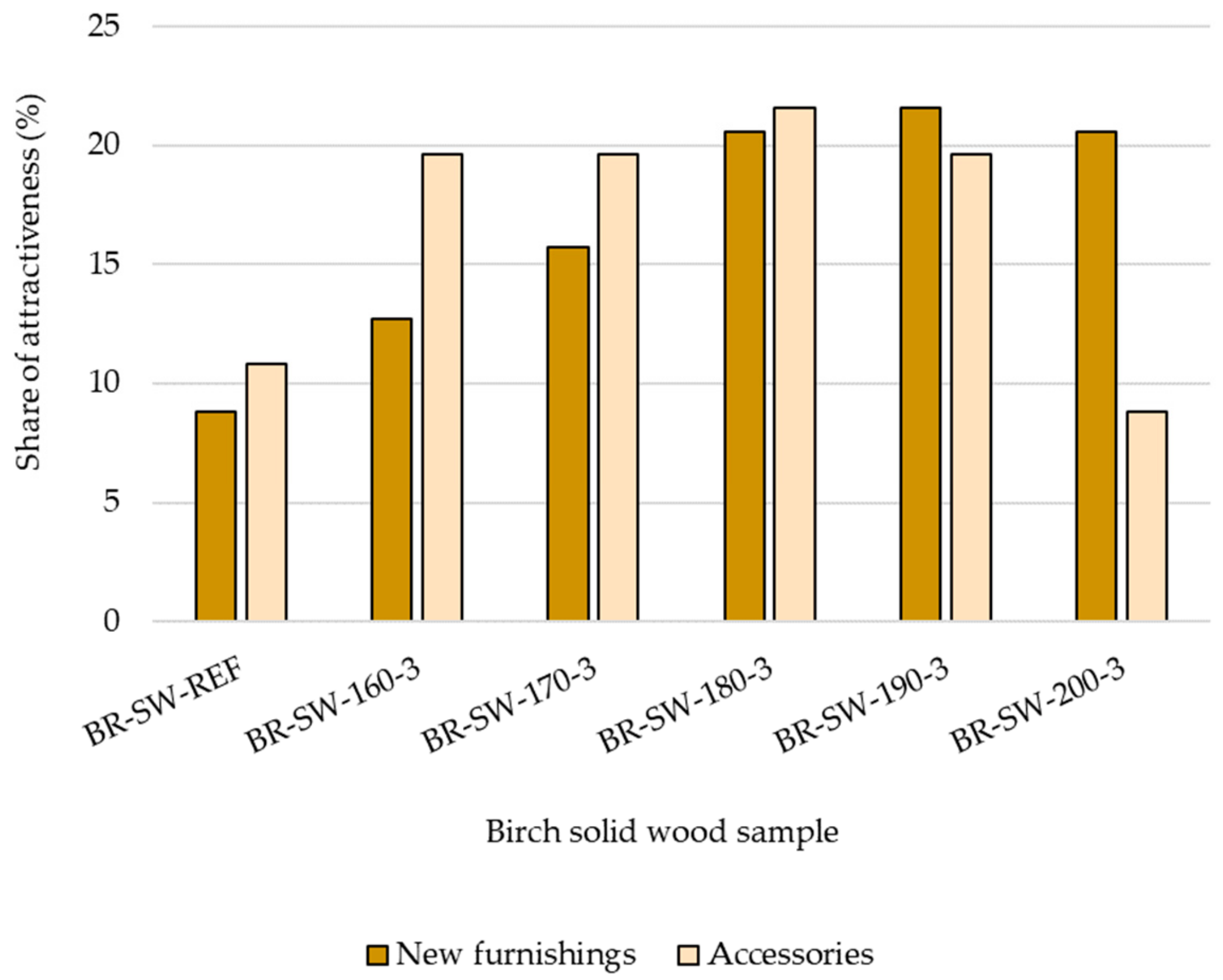

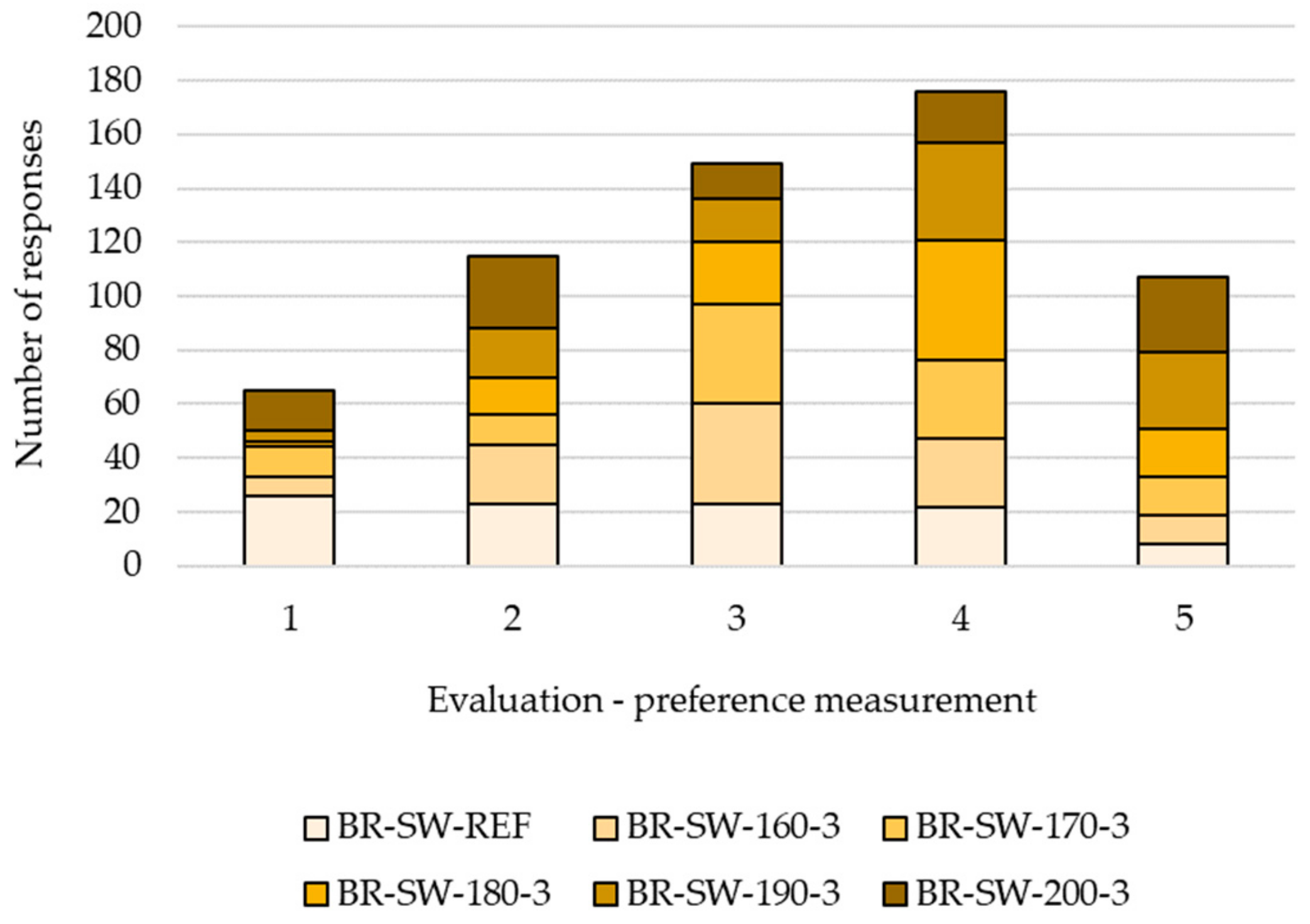
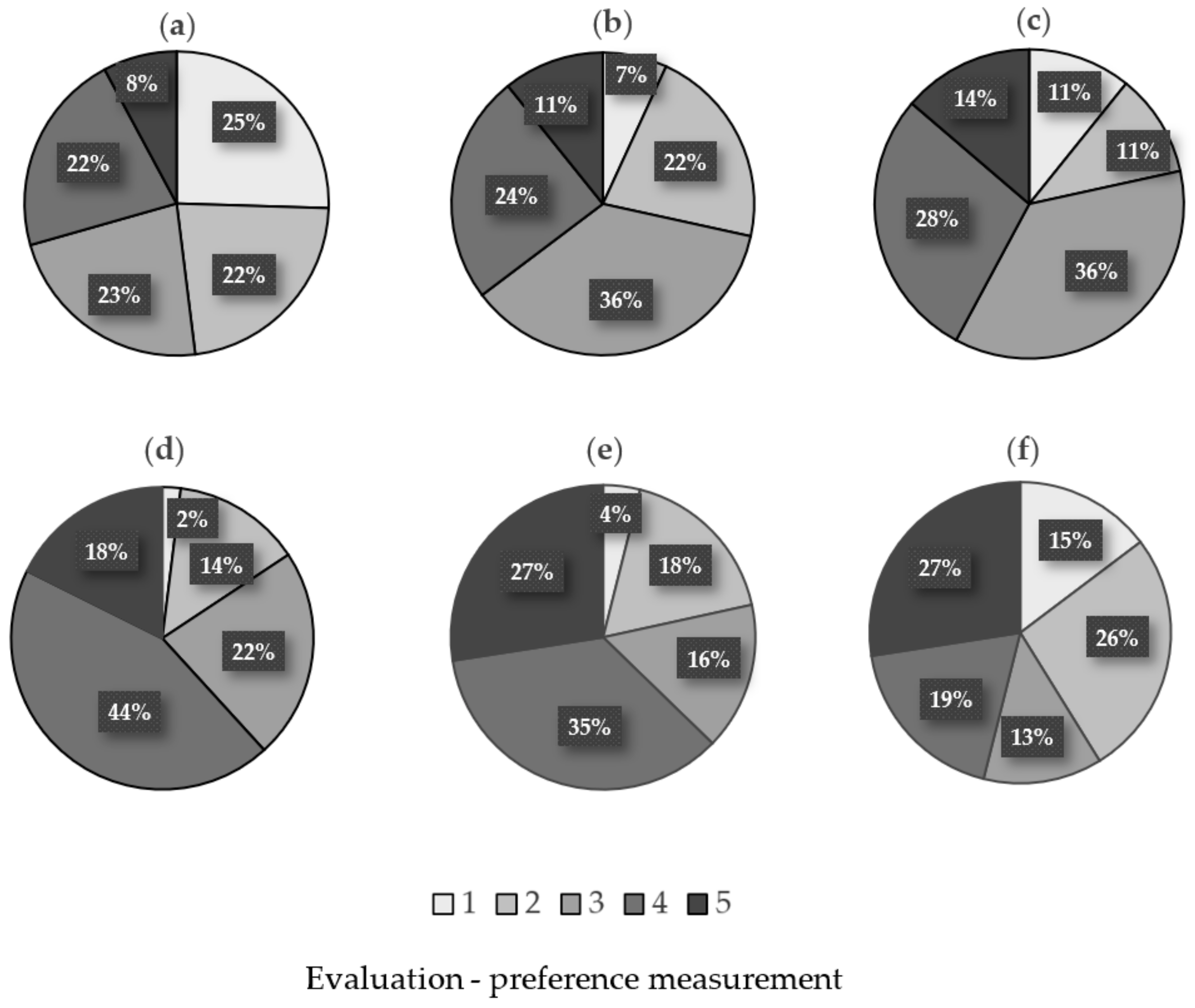

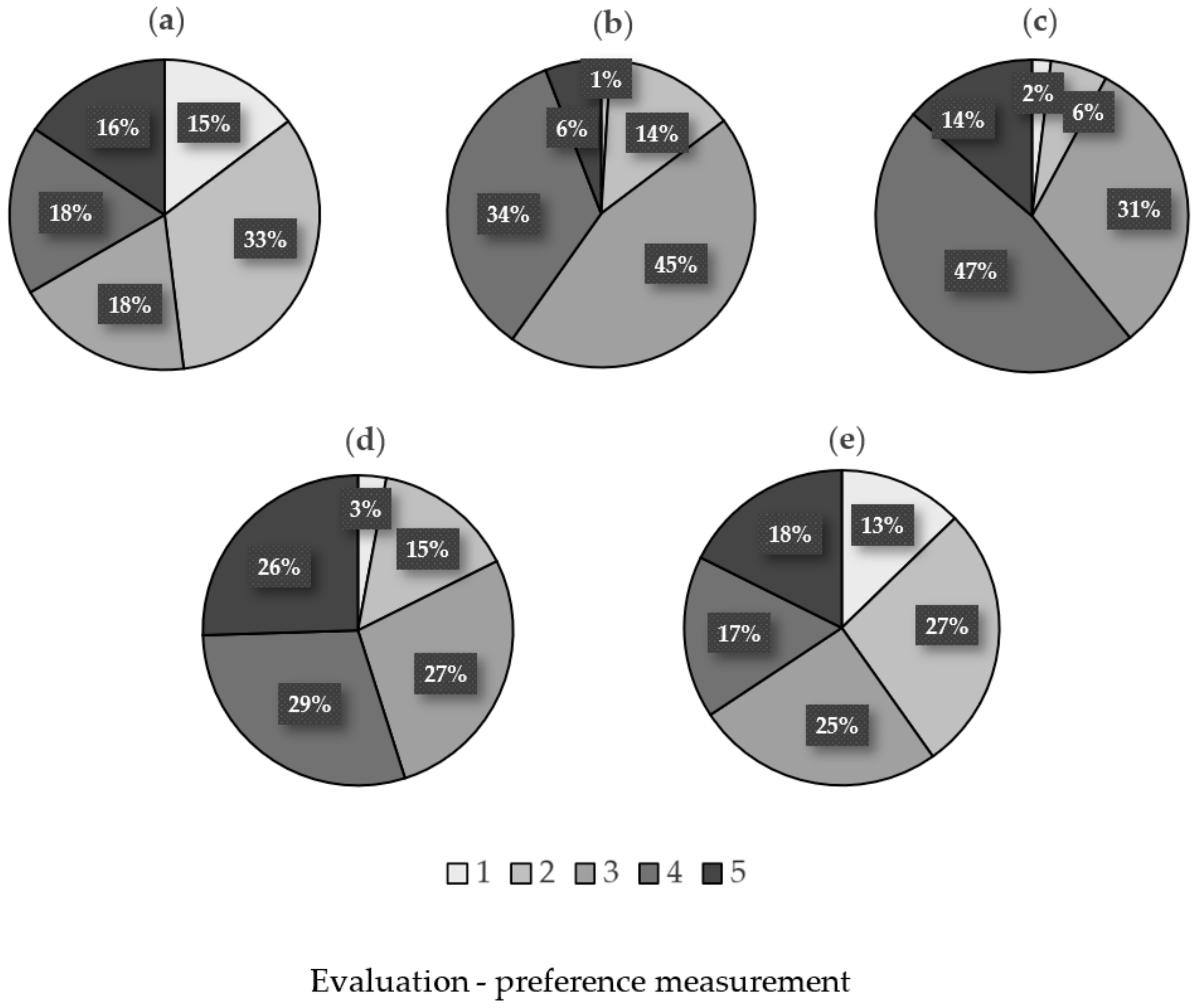
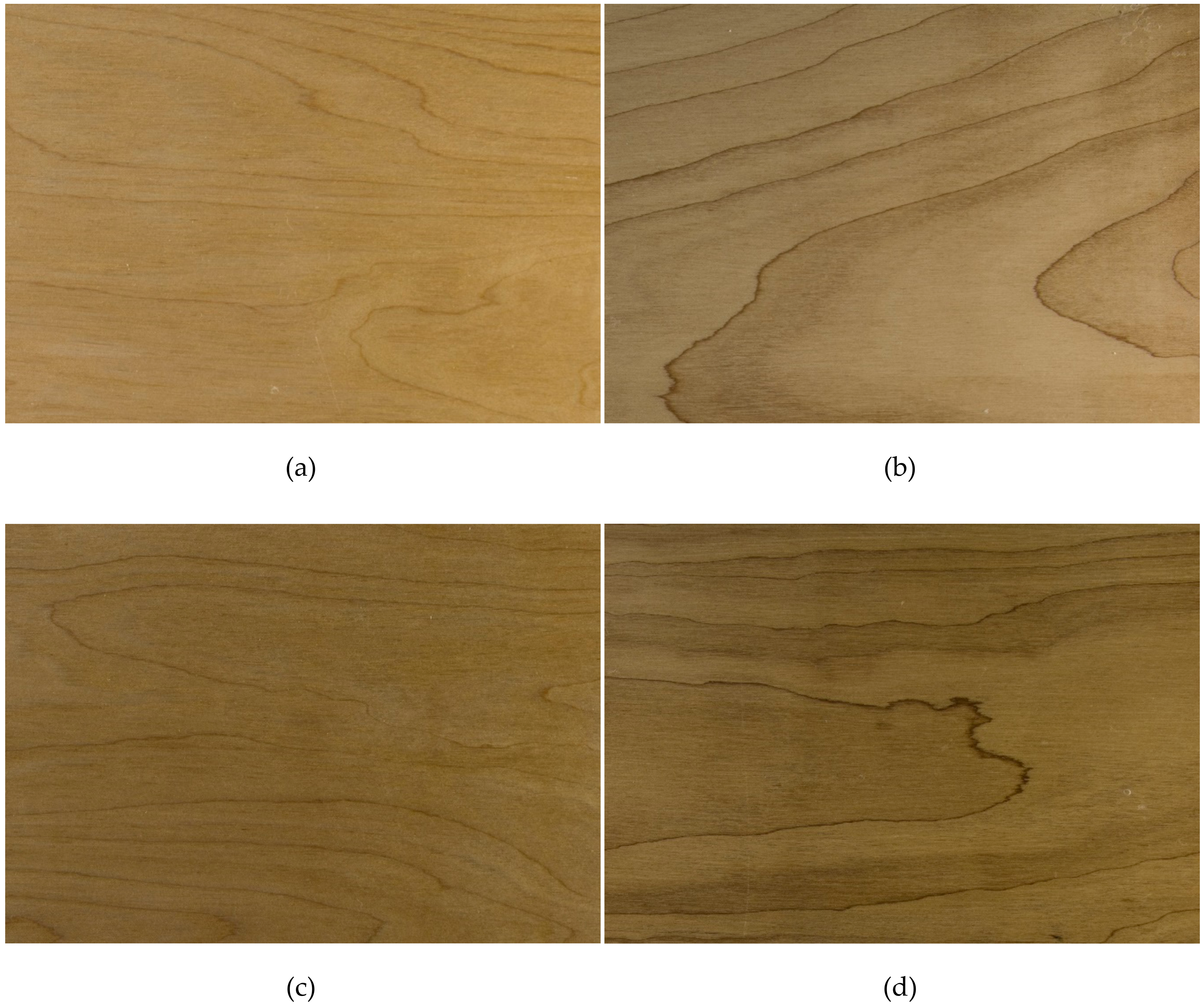
| Mean Std.Dev. | BR-REF | BR-170-1 | BR-170-3 | BR-170-5 | BR-190-1 | BR-190-3 | BR-190-5 | BR-200-1 | BR-200-2 | BR-200-3 |
|---|---|---|---|---|---|---|---|---|---|---|
| Ra (μm) | 2.666 | 4.006 | 3.280 | 3.560 | 1.833 | 1.369 | 2.396 | 3.074 | 1.515 | 1.551 |
| 0.967 | 1.691 | 1.491 | 1.100 | 1.272 | 0.827 | 1.763 | 2.614 | 0.326 | 1.508 | |
| Rz (μm) | 33.796 | 37.492 | 49.256 | 42.647 | 19.491 | 18.662 | 19.851 | 33.100 | 15.938 | 18.748 |
| 15.069 | 13.697 | 22.016 | 18.468 | 9.092 | 9.121 | 11.420 | 17.353 | 2.471 | 18.636 | |
| RSm (μm) | 58.999 | 59.248 | 63.149 | 48.701 | 37.851 | 50.302 | 47.800 | 53.444 | 74.702 | 48.657 |
| 13.759 | 14.869 | 19.613 | 19.799 | 25.877 | 24.192 | 20.748 | 12.569 | 15.941 | 20.567 | |
| Rc (μm) | 11.075 | 12.666 | 12.276 | 10.208 | 4.829 | 5.937 | 8.737 | 8.950 | 7.641 | 6.492 |
| 3.476 | 5.634 | 4.759 | 3.881 | 1.543 | 3.426 | 7.153 | 3.615 | 1.558 | 5.760 |
| Mean Std.Dev. | BR-REF | BR-170-1 | BR-170-3 | BR-170-5 | BR-190-1 | BR-190-3 | BR-190-5 | BR-200-1 | BR-200-2 | BR-200-3 |
|---|---|---|---|---|---|---|---|---|---|---|
| Ra (μm) | 2.005 | 2.131 | 2.080 | 2.545 | 2.256 | 2.500 | 2.004 | 1.948 | 2.104 | 1.835 |
| 0.165 | 0.204 | 0.151 | 0.164 | 0.198 | 0.138 | 0.144 | 0.246 | 0.232 | 0.199 | |
| Rc (μm) | 11.671 | 11.270 | 11.377 | 12.569 | 10.495 | 12.074 | 10.351 | 9.873 | 10.844 | 9.267 |
| 1.169 | 1.111 | 1.101 | 1.010 | 0.953 | 0.870 | 0.915 | 1.443 | 1.290 | 1.210 | |
| RSm (μm) | 103.010 | 93.563 | 95.014 | 91.817 | 80.000 | 92.197 | 89.377 | 84.742 | 84.501 | 85.442 |
| 14.624 | 8.287 | 13.392 | 15.894 | 9.834 | 8.914 | 12.505 | 14.067 | 15.089 | 11.372 |
| Mean Std.Dev. | BK-REF | BR-REF | BR-170-1 | BR-170-3 | BR-170-5 | BR-190-1 | BR-190-3 | BR-190-5 | BR-200-1 | BR-200-2 | BR-200-3 |
|---|---|---|---|---|---|---|---|---|---|---|---|
| L* | 69.92 | 82.94 | 76.19 | 70.94 | 70.11 | 66.12 | 63.32 | 55.84 | 59.10 | 57.03 | 51.33 |
| 3.54 | 6.12 | 1.10 | 1.30 | 1.02 | 1.17 | 1.41 | 1.64 | 4.86 | 1.65 | 1.33 | |
| a* | 9.14 | 3.50 | 6.60 | 8.22 | 8.53 | 9.43 | 10.75 | 11.07 | 10.86 | 10.66 | 11.71 |
| 1.16 | 0.37 | 0.44 | 0.46 | 0.37 | 0.36 | 7.82 | 0.88 | 0.28 | 0.35 | 0.86 | |
| b* | 22.84 | 17.12 | 22.22 | 26.20 | 25.32 | 26.88 | 27.17 | 26.34 | 26.34 | 24.80 | 25.10 |
| 1.05 | 0.45 | 0.62 | 18.18 | 1.01 | 0.99 | 1.61 | 0.65 | 0.55 | 0.73 | 0.71 | |
| ΔE* | 74.16 | 84.81 | 79.64 | 76.80 | 75.04 | 72.01 | 70.04 | 62.74 | 65.71 | 63.11 | 58.34 |
| 3.00 | 5.42 | 0.92 | 14.84 | 0.88 | 0.92 | 4.73 | 1.44 | 3.20 | 1.52 | 1.17 | |
| Hardness (MPa) | 38 | 30 | 29 | 28 | 30 | 31 | 32 | 32 | 38 | 36 | 39 |
| 8 | 9 | 7 | 8 | 7 | 8 | 8 | 8 | 9 | 10 | 9 | |
| Density ** (kg/m3) | 711 | 608 | 598 | 586 | 592 | 593 | 595 | 570 | 599 | 568 | 577 |
| 8 | 9 | 3 | 3 | 5 | 16 | 4 | 7 | 22 | 12 | 5 |
| Mean | BK-REF | BR-REF | BR-170-1 | BR-170-3 | BR-170-5 | BR-190-1 | BR-190-3 | BR-190-5 | BR-200-1 | BR-200-2 | BR-200-3 |
|---|---|---|---|---|---|---|---|---|---|---|---|
| Standard Deviation | |||||||||||
| Water contact angle—after 5 s (°) | 106.3 | 94.3 | 119.8 | 117.4 | 117.7 | 117.4 | 117.4 | 122.6 | 114.9 | 123.2 | 121.6 |
| 8.2 | 12.9 | 6.7 | 5.9 | 7.0 | 4.3 | 12.3 | 13.1 | 10.5 | 4.5 | 6.1 | |
| Water contact angle—immediate (°) | 115.6 | 108.1 | 123.1 | 124.6 | 109.0 | 113.0 | 113.6 | 132.1 | 114.2 | 124.2 | 113.5 |
| 2.4 | 4.7 | 2.1 | 1.5 | 2.7 | 3.6 | 2.7 | 3.0 | 2.9 | 2.2 | 1.2 | |
| Drop diameter—immediate (mm) | 1.474 | 1.609 | 1.296 | 1.288 | 1.591 | 1.529 | 1.495 | 1.160 | 1.514 | 1.292 | 1.486 |
| 0.047 | 0.084 | 0.049 | 0.024 | 0.045 | 0.063 | 0.045 | 0.053 | 0.049 | 0.048 | 0.045 | |
| Water contact angle—after 1 min (°) | 72.2 | 46.4 | 82.0 | 87.8 | 80.1 | 80.6 | 80.1 | 107.1 | 76.8 | 80.9 | 85.9 |
| 2.4 | 4.4 | 6.7 | 4.3 | 2.0 | 2.6 | 2.9 | 7.2 | 4.8 | 5.2 | 5.5 | |
| Drop diameter—after 1 min (mm) | 2.179 | 2.853 | 2.055 | 1.954 | 2.178 | 2.172 | 2.144 | 1.586 | 2.176 | 2.044 | 1.978 |
| 0.043 | 0.186 | 0.155 | 0.082 | 0.034 | 0.039 | 0.051 | 0.093 | 0.053 | 0.107 | 0.147 | |
| Water contact angle—after 2 min (°) | 66.5 | 36.8 | 72.4 | 77.5 | 67.3 | 69.1 | 74.4 | 97.6 | 67.6 | 70.7 | 78.1 |
| 2.2 | 5.3 | 9.5 | 6.4 | 2.7 | 2.3 | 3.7 | 5.6 | 2.2 | 8.3 | 6.8 | |
| Drop diameter—after 2 min (mm) | 2.229 | 2.922 | 2.188 | 2.125 | 2.381 | 2.326 | 2.206 | 1.716 | 2.285 | 2.213 | 2.100 |
| 0.053 | 0.184 | 0.203 | 0.117 | 0.072 | 0.070 | 0.070 | 0.084 | 0.058 | 0.191 | 0.154 |
| Type of Purchase | Sample Group | Share of the Respondents | Interval Estimation of the Share in Population |
|---|---|---|---|
| Equipment of new apartment/house | solid wood | 0.912 | 0.857–0.967 |
| veneer | 0.824 | 0.750–0.898 | |
| Supplementary accessories | solid wood | 0.892 | 0.832–0.952 |
| veneer | 0.824 | 0.750–0.898 |
© 2020 by the authors. Licensee MDPI, Basel, Switzerland. This article is an open access article distributed under the terms and conditions of the Creative Commons Attribution (CC BY) license (http://creativecommons.org/licenses/by/4.0/).
Share and Cite
Dudík, R.; Borůvka, V.; Zeidler, A.; Holeček, T.; Riedl, M. Influence of Site Conditions and Quality of Birch Wood on Its Properties and Utilization after Heat Treatment. Part II—Surface Properties and Marketing Evaluation of the Effect of the Treatment on Final Usage of Such Wood. Forests 2020, 11, 556. https://doi.org/10.3390/f11050556
Dudík R, Borůvka V, Zeidler A, Holeček T, Riedl M. Influence of Site Conditions and Quality of Birch Wood on Its Properties and Utilization after Heat Treatment. Part II—Surface Properties and Marketing Evaluation of the Effect of the Treatment on Final Usage of Such Wood. Forests. 2020; 11(5):556. https://doi.org/10.3390/f11050556
Chicago/Turabian StyleDudík, Roman, Vlastimil Borůvka, Aleš Zeidler, Tomáš Holeček, and Marcel Riedl. 2020. "Influence of Site Conditions and Quality of Birch Wood on Its Properties and Utilization after Heat Treatment. Part II—Surface Properties and Marketing Evaluation of the Effect of the Treatment on Final Usage of Such Wood" Forests 11, no. 5: 556. https://doi.org/10.3390/f11050556





